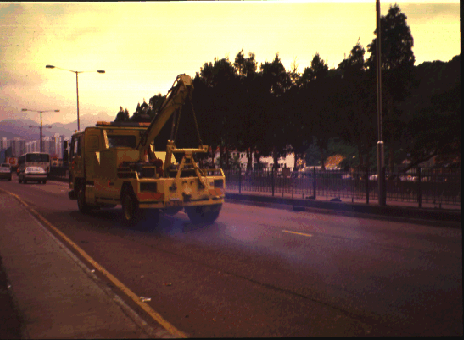 Air pollution index
Air pollution indexPollution forecast acts as an `alarm' for air quality



 Air pollution index
Air pollution index
Pollution forecast acts as an `alarm' for air quality
The Air Pollution Index provides a simple and uniform way to forecast daily air quality.
Said Ms Lilian Chan, a senior information officer of Environmental Protection Department: “The index serves as a basis for advising the public before any onset of air pollution incidents.
“Timely information about air pollution levels will increase the public awareness on air quality.
“Citizens, especially those who have heart or respiratory problems, need to consider taking precautions when the air quality deteriorates,” she said.
Air Pollution Index is based on the measurement of several air pollutants including nitrogen dioxide, sulphur dioxide, ozone, carbon monoxide and particulate matter.
Nine air quality monitoring stations have been set up in Kwun Tong, Mong Kok, Sham Shui Po, Kwai Chung, Tsuen Wan, Shatin, Tai Po, Yuen Long and Central and Western.
“Different pollutant concentrations will be monitored first and then transformed into an index ranges in value from zero to 500,” Ms Chan said.
Air Pollution Index is classified into four grades: index from zero to 50 represents ‘good’, 51 to 100 represents ‘moderate’, 101 to 200 represents ‘unhealthy’ and 201 to 500 signifies ‘very unhealthy’.
When the index reaches ‘unhealthy level’, citizens will suffer mild discomfort. People with heart or respiratory problems are not suggested to take any physical exertion and outdoor activities.
If the index exceeds 200, the public will experience symptoms such as eye irritation, wheezing, coughing, phlegm and sore throats. People are advised to reduce physical exertion and outdoor activities.
According to Ms Chan, the Education Department has issued a circular on Air Pollution Index and the arrangements carried out when the index exceeds 200.
“Children need not go to school when the index exceeds 200,” Ms Chan said.
The Territory has been divided into three types of area: urban, industrial and new development areas.
Urban areas include Central and Western, Wan Chai, Eastern, Kowloon City, Sham Shui Po, Wong Tai Sin and Yau Tsim Mong districts. Industrial area covers Kwun Tong, Kwai Tsing and Tsuen Wan districts while new development areas include the islands, Southern, Sai Kung, Tuen Mun, Yuen Long, Sha Tin, Tai Po and North districts.
“From 1990 to 1994, the number of days that fell in the ‘unhealthy’ category was 29 in the industrial area and 25 in the urban areas. There were no ‘very unhealthy’ days recorded,” said Ms Chan.
Despite the high praise from the Environmental Protection Department itself, the usefulness of the Air Pollution Index is doubtful to some parties.
Friends of the Earth Campaigns Officer Cheng Luk Ki said, “The Air Pollution Index is far from satisfactory.”
He pointed out that of all the air monitoring stations, only the station in Mong Kok is located at two meters above the ground. Other stations are located at 17 to 25 metres above the ground, which is equivalent to the fourth or sixth floor of a building.
“The index can only measure and tabulate rooftop air pollution level with no regards to street-level air pollution readings.
“Then, a person can have a sense of security only if he lives in the tenth floor and spends all his time inside the house,” he said.
“You will realise how “To make the index more meaningful to the public, readings should be monitored from the ground,” Mr. Cheng suggested.
However, the Environmental Protection Department still regard that it is correct to choose rooftop readings because most people spend their time in buildings.
Mr. Luk Chi Wing, 19, of Kwun Tong said the air pollution reading meant nothing to him.
“The index is just a window-dressing made by the government to show that it has done something on air pollution problems. In fact, it still cannot root out the problems.
“It is impossible to stay at home all the day even when the index reaches a very unhealthy level. We still need to go to school or to work as usual,” Mr. Luk said.
Mr. Cheng said that spending about $7 million dollars to reveal the seriousness of air pollution is not enough.
“More resources should be allocated to prevent the deterioration of air quality in the Territory instead,” Mr. Cheng concluded.


